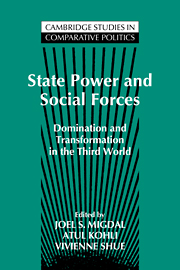Book contents
- Frontmatter
- Contents
- Preface
- List of contributors
- State Power and Social Forces
- Introduction: developing a state-in-society perspective
- PART I THEORETICAL AND METHODOLOGICAL CONSIDERATIONS
- PART II STATES: EMBEDDED IN SOCIETY
- 2 Traditional politics against state transformation in Brazil
- 3 State power and social organization in China
- 4 Centralization and powerlessness: India's democracy in a comparative perspective
- 5 States and ruling classes in postcolonial Africa: the enduring contradictions of power
- PART III SOCIAL FORCES: ENGAGED WITH STATE POWER
- PART IV CONCLUSION
- Index
4 - Centralization and powerlessness: India's democracy in a comparative perspective
Published online by Cambridge University Press: 05 June 2012
- Frontmatter
- Contents
- Preface
- List of contributors
- State Power and Social Forces
- Introduction: developing a state-in-society perspective
- PART I THEORETICAL AND METHODOLOGICAL CONSIDERATIONS
- PART II STATES: EMBEDDED IN SOCIETY
- 2 Traditional politics against state transformation in Brazil
- 3 State power and social organization in China
- 4 Centralization and powerlessness: India's democracy in a comparative perspective
- 5 States and ruling classes in postcolonial Africa: the enduring contradictions of power
- PART III SOCIAL FORCES: ENGAGED WITH STATE POWER
- PART IV CONCLUSION
- Index
Summary
During the 1970s and 1980s, a recurring pattern characterized political change in India: Control over governmental decisions tended to centralize in leaders who ruled by virtue of personal popularity, but who found it difficult to transform their personal power into a problem-solving political resource. A number of political consequences typically followed. Governmental legitimacy became hard to sustain; there was a high leadership turnover below the highest ranks; the state continued to perform at a low level of efficacy – in terms both of accommodating conflicting interests and of solving developmental problems; and political violence as well as poverty continued to dominate the political landscape. This chapter attempts to explain the roots of the simultaneous tendencies toward centralization and powerlessness in India's low-income democracy.
It is argued that such tendencies toward centralization and powerlessness are generated by the near absence of systematic authority links between the state's apex and the vast social periphery. In years past, especially during the 1950s, India's nationalist party, the Congress, forged patronage links with regional and local influentials, thus creating a chain of authority that stretched from the capital city to villages. Over the last two decades or so, these links in the authority structure eroded, owing to a number of forces: The spread of democratic politics undermined the influence of regional and local traditional elites; and the nationalist party-qua-organization was destroyed by intra-elite conflict and by the recalcitrance of power-hungry national leaders.
- Type
- Chapter
- Information
- State Power and Social ForcesDomination and Transformation in the Third World, pp. 89 - 107Publisher: Cambridge University PressPrint publication year: 1994
- 17
- Cited by



